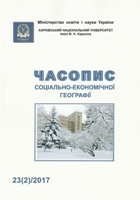Social-geographic approaches to application of economic-mathematical modeling in predicting the place of Ukrainian farming economies in food market commoditization
Abstract
Social-geographic analysis of farmery with application of economic-mathematical modeling allowed for prediction of farming economies’ role in food market commoditization. The equation of potential demand was suggested. Actual consumption and its recommended rates with respect to meat and meat products, milk and milk products, eggs, fish and fish products, bread and cereal products, potatoes, vegetables, fruits and berries, etc, were compared. Cartographic model of Ukrainian domestic food market’s potential capacity (within good-money relations) was developed. The low level of purchasing power, especially in rural population, makes a high percentage of foodstuffs be beyond the goods-money relations. In rural areas, they (inclusive of farmers) produce and consume a significant portion of foodstuffs that escaped the goods-money relations, or such foodstuffs were given to them by the relatives. We regard that in the process of assessment of the capacity of domestic food market, this share of products should also be taken into account. The assessment also necessitates consideration of the number of urban and rural population in Ukrainian regions; manufacturing of certain types of agricultural production; needs in this or that type of product as prescribed by minimal and rational consumption rates. When predicting, with the use of economic-mathematical modeling, the places of farming economies in commoditization of food market, it is reasonable to apply the parameters of time series of the number of farming economies and the areas of lands used by them with consideration of the dynamics of population number and the level of its (population) self-provision with agricultural production. Application of predictive linear models shows that the share of production manufactured by farming economies will be most essential before 2020 on the market of potatoes and vegetables (reaching 15 %). Despite the predicted double increase in animal production, its share will stay to be insignificant (3-5 %).
Downloads
References
2. Zaiachuk, M.D. (2015). Geoprostorova organizatsiya fermerskoho ukladu Ukrainy [Geospatial Organization of Farming Mode in Ukraine]. Chernivtsi: Bukrek, 520.
3. Zayachuk, M. (2013). Geogratial particularities of farming formation in Ukraine. Geographia Technica, 2, 80-88.
4. Shpychak, O.M., Lupenko, Yu.O., Zhuk, V.M. (2013). Yemnist vnutrishnoho spozhyvnoho rynku silskohospodarskoi produktsii ta prodovolstva. K.: NNTs IAE, 186.
5. Statystychnyi zbirnyk „Silske hospodarstvo Ukrainy za 2013 rik” (2014) [“2013 Ukrainian Agriculture”, a Statistical Collection]. Derzhavna sluzhba statystyky; za red. N.S. Vlasenko. K.: DP „Informatsiino-analitychne agentstvo”, 386.
Copyright (c) 2017 Valeriy Rudenko, Vasyl Hryhorkiv, Myroslav Zaiachuk, Sviatoslav Ishchenko

This work is licensed under a Creative Commons Attribution 4.0 International License.




